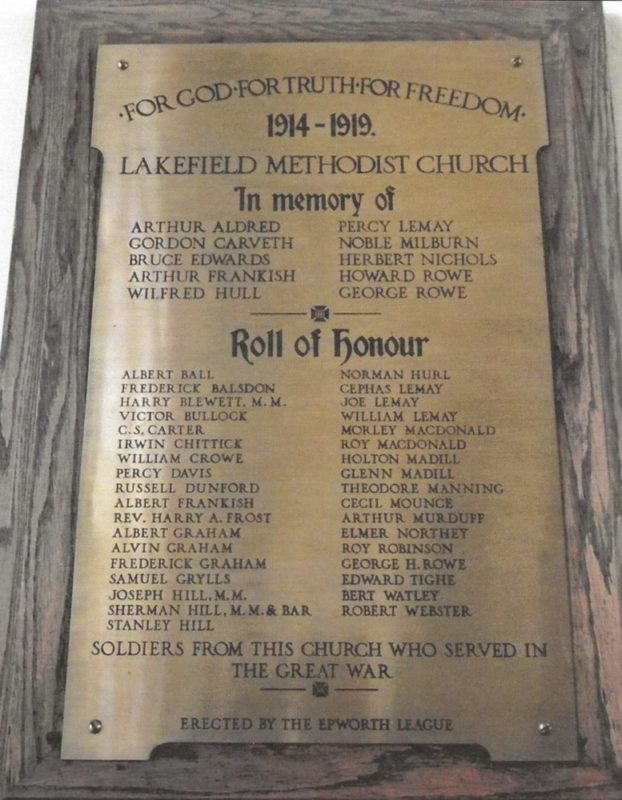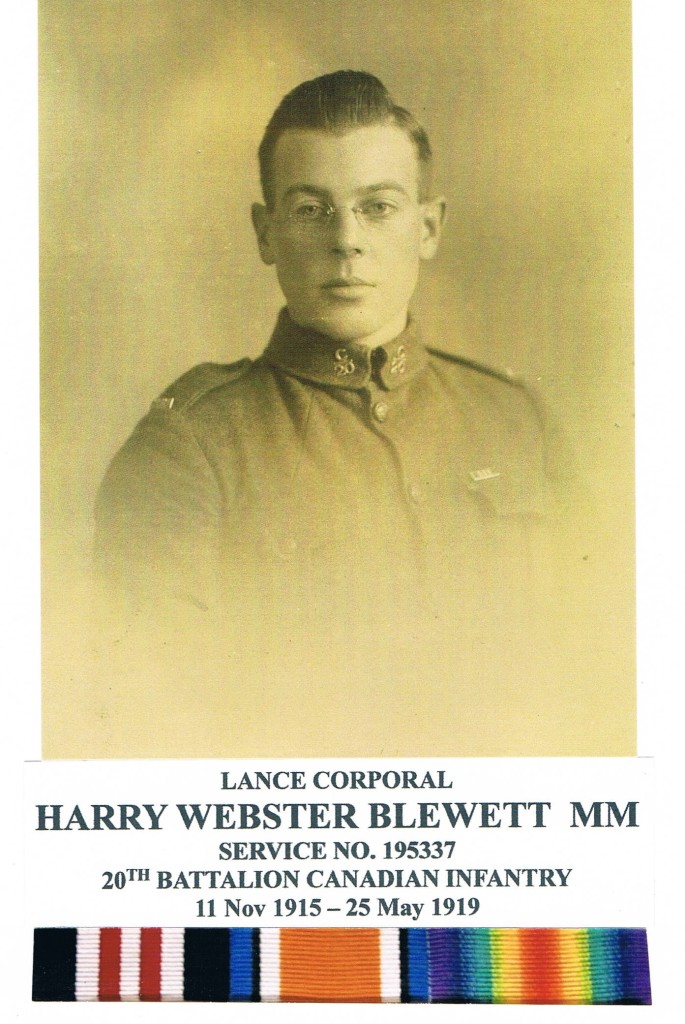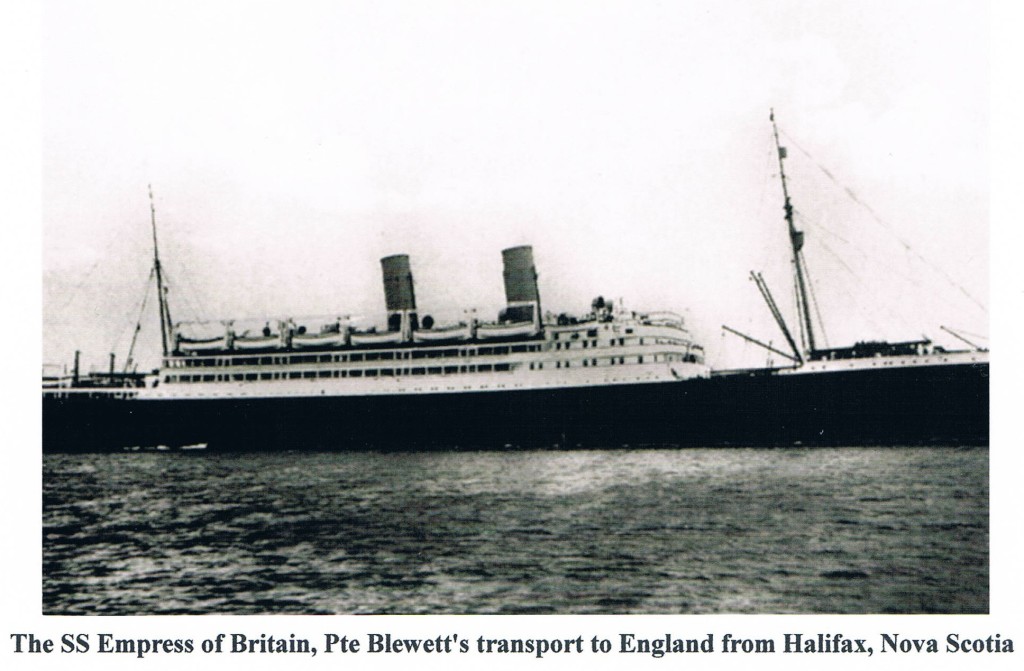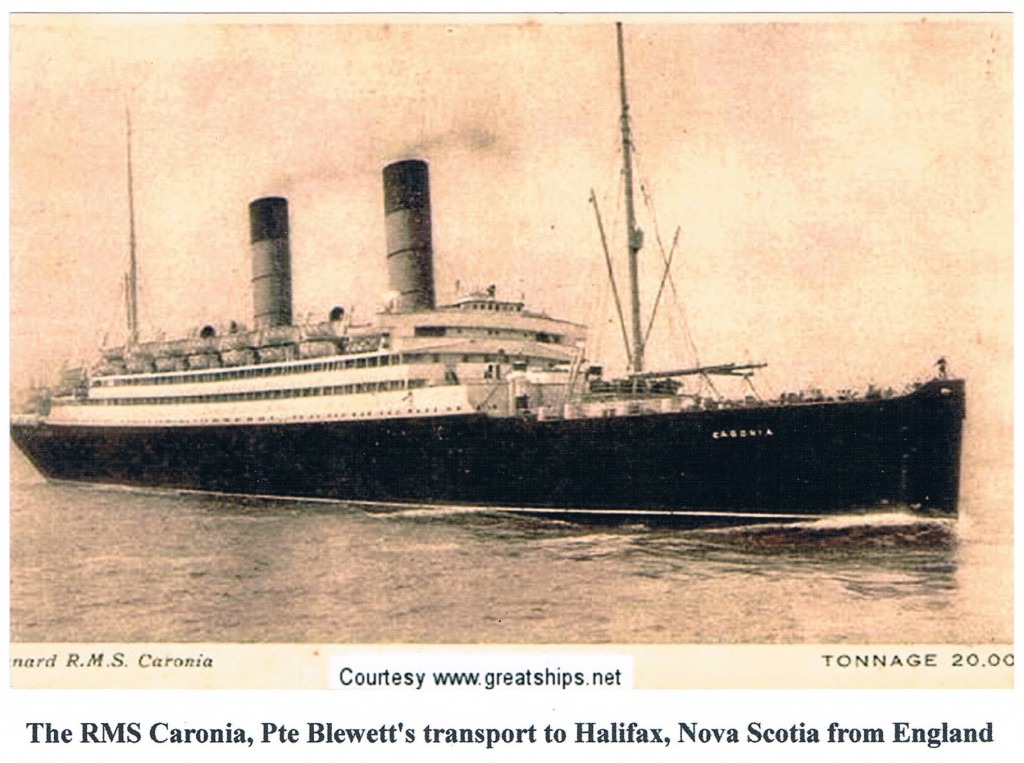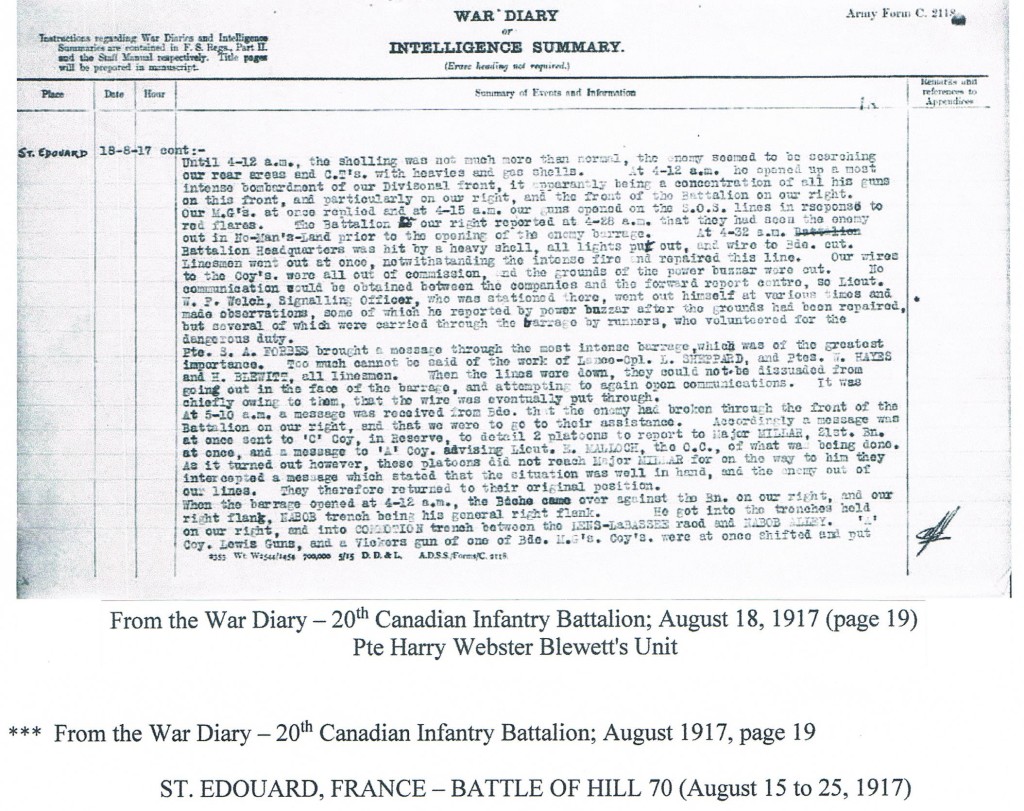MILITARY HISTORY
Private Harry Webster Blewett – 195337 – ACTIVE SERVICE (World War I)
On November 11, 1915, Harry Webster Blewett completed the Attestation Paper for the Canadian Army (Expeditionary Force). He was 22 years, and 7 months old when, as a single man, he enlisted for the duration of the War. Harry Webster was born in Warsaw, Peterborough County, Ontario, and gave his birth-date as April 17, 1893. On his Attestation Paper, Harry indicated, he did not presently belong to an Active Militia, but that he had served with the 46th Regiment of Lakefield for 1 year. There is nothing on his File to indicate where he was educated or to what level. As far as employment is concerned, he lists Clerk. Harry Webster was 5′ 4” tall, 40½”chest (expanded). His complexion is listed as fresh, he had blue eyes, and dark brown hair. A Medical Examination at the time of his enlistment indicated that his weight was 153 pounds, and that his eyesight was slightly defective. Aside from this, he had no other medical issues, and as was deemed fit for Overseas duty with the Canadian Army (Expeditionary Force). His next-of-kin was listed as his father Mr Jonathan Blewett of Lakefield. Harry Webster Blewett signed the Oath and Certificate of Attestation November 11, 1915, in Peterborough, Ontario. The Certificate of Magistrate was signed by the Justice on, what appears to be November 29, 1915. Harry Blewett was taken-on-strength with the 93rd Battalion (Bn) (Peterborough), when it was authorized and formed up on December 22, 1915. Harry was assigned the rank of Private and Regimental Number 195337.
Pte Blewett’s File does not have any notation as to what he was doing the first 3 months after enlisting. The standard procedure would have had him doing basic training with the 93rd Bn in Peterborough before being transferred to Valcartier, Québec about February 1916 for more advanced Infantry Training. Valcartier was constructed as a Military Base in August 1914, as part of the mobilization of the Canadian Expeditionary Force, at the outset of World War I. The Base was located approximately 16 miles north of Québec City. Training which was pretty rudimentary, consisting of marching, rifle, and bayonet drills. The officers were trained in the correct use of a pistol and practiced swordsmanship. The main goal of the Base was to form the men into Units and ship them off to England as quickly as possible, when their training had been completed. Pte Blewett and the 93rd Bn embarked, from Halifax, Nova Scotia, on July 15, 1916, aboard the SS Empress of Britain.
Pte Blewett disembarked at Liverpool, England on July 25, 1916. On September 15, 1916, he was transferred from the 93rd Bn to the 20th Battalion (Bn) stationed at Canadian Base Depot, Otterpool, England. On September 16, 1916, Pte Blewett was taken-on-strength with the 20th Bn*. He departed for the 2nd Canadian Engineer (CE) Bn on September 29, 1916 and arrived October 2, 1916. Pte Blewett then departed for the 20th Bn on October 2, 1916 and arrived October 3, 1916. For about the next 9 months he would have been in training with the 20th Bn. Pte Blewett was a qualified Clerk and Signalman, trained as a Lineman; the Courses for these qualifications probably occurred in this time period. There are no notations in his File to indicate when he embarked at England and disembarked at France. Pte Blewett probably was in France about March 1917 and would have been in the Field with the 20th Bn.
On August 18, 1917 Pte Blewett was at St. Edouard, France with the 20th Bn to initiate the Battle of Hill 70. That morning, until 4:12 a.m. the shelling was about normal but then there was heavy bombardment from the Germans which caused a great deal of damage, especially to the lines-of-communication. During the heavy bombardment Pte Blewett, a trained Lineman, and two other Linemen ventured out into the intense barrage on a number of occasions to fix wires so there was communication with the other Battalions. The Force assembled there attacked the German Line and were successful in taking the City of St. Edouard, the first step to taking Hill 70. Pte Blewett was cited for the Military Medal** based on his heroic actions in the face of great peril. Undoubtedly the other two Linesmen would have been cited as well. ***See the copy of the excerpt from the War Diary (Page 4) and the Citation (Page 6).
On November 11, 1917, Pte Blewett was awarded the Good Conduct Badge (inverted Chevron). This Badge was awarded based on Pte Blewett having completed one year of Service and having “no disciplinary entries in the Regimental Conduct Book”. On November 19, 1917, he was “awarded the Military Medal for bravery in the Field”. At this point in time, the 2nd Battalion (CEF) was in the area of Passchendaele. The Battle of Passchendaele was known as the “slaughter in the mud”. Also on November 19, 1917, Pte Blewett was granted a 14 day Leave. He reported back from Leave December 5, 1917.
Generally, during the months of December to March, offensive operations (by both sides) were stopped based on the weather. Military operations were mostly restricted to one of survival in the rain, fog, mud-fields, water logged trenches and shell holes.
Pte Blewett was wounded (gunshot wound to left neck) on August 8, 1918. August 9, 1918; he was admitted to No 5 General Hospital, located in Rouen, France. On August 12, 1918, he was transferred to the 74th General Hospital, located at Trouville, France. Following treatment, on August 15, 1918, Pte Blewett was transferred to No 13 Convalescence Depot, also located at Trouville, France. On September 6, 1918, he was discharged from the No 13 Convalescence Depot and reported to Canadian Reinforcement Base, located at Étaples, France. On September 18, 1918, Pte Blewett left for his Unit, in the field; on September 20, 1918, he arrived at his Unit. Pte Blewett was on a Training Course with the Canadian Corps from October 9, 1918 to November 16, 1918; subject of the Couse was not noted. He was granted a 14 day Leave to the UK on November 24, 1918. Following the completion of his Leave, Pte Blewett was attached to Canadian Corps Reinforcement Camp No 2. On December 24, 1918, he left to rejoin his Unit, in France. He arrived, at his Unit on December 27, 1918.
Pte Blewett was promoted to Acting Lance Corporal (A/L/Cpl) on February 11, 1919. On April 5, 1919, embarked France for England and disembarked England the same day. On April 6, 1919, he was struck-off-strength from the 20th Battalion, and was taken-off-strength with Q Wing, at Witley Common, Surrey, England waiting repatriation to Canada.
A/L/Cpl Blewett was struck-off-strength from the Overseas Military Forces of Canada, on May 8, 1919. He embarked from Liverpool, England, on May 14, 1919, aboard the RMS Caronia.
On May 14, 1919, Pte Blewett was taken-off-strength with No 2 District Depot, Toronto. He disembarked, in Halifax, around May 21, 1919, where he would have boarded, a Troop Train, bound for No 2 District Depot, located in Toronto, Ontario. The 20th Battalion arrived at the North Toronto Station of the CPR (now Summerhill Subway Station) on May 24, 1919 and marched to an official reception in Varsity Stadium: “Police were powerless to stem the rush of friends and relatives who had been waiting, the Battalion’s arrival, for what seemed like hours. The speeches of welcome were never given, as the Battalion dismissed itself”. The following day, the 20th Battalion CEF was officially demobilized. A/L/Cpl Blewett MM was discharged, on demobilization, from His Majesty’s Service on May 25, 1919″.
Beyond the reference to A/L/Cpl Blewett being awarded the Military Medal, in 1917, there is no indication in his Military File as to what other Medals he was awarded, but based on his Military Service he would have received the:
Military Medal;
British War Medal; and
Victory Medal.
He was also awarded War Service Badge – CEF Class “A”
For the purpose of calculating his Military Service, in the different regions, it was decided to calculate his arrival in France as the end of October 1916. A/L/Cpl Blewett served with the Canadian Army a total of 3 years, 8 months and 8 days; 9 months and 18 days in Canada; 2 years, 4 months and 24 days in France and 5 months and 25 days in the UK.
* The 20th Canadian Battalion, a Central Ontario Unit, was part of the 4th Canadian Brigade, 2nd Canadian Division, and fought in many of the main Battles in the First World War, namely: the Battle of the Somme (July 1, to November 18, 1916); the battle of Vimy Ridge (April 9 to 12, 1917); following Vimy Ridge, the Battalion spent the summer in intensive training exercises, learning the new principles of fire and movement; the Battle of Hill 70 (August 15 to 25, 1917); the Battle of Passchendaele (3rd Battle of Ypres) (July 31 to November 10, 1917); the 100 day Offensive (August 8 to November 11, 1918), which included the Battle of Ameins, and the Pursuit to Mons, Belgium (November 1 to 11, 1918).
In the last 24 hours, of the War, before the Armistice, the Battalion lost 1 Officer, 11 other ranks, and 30 other ranks wounded. It also captured the last prisoner taken by a Canadian Unit, at 10 a.m., November 11, 1918 at Mons, Belgium. There was some controversy following the Battle of Mons and the loss of these lives as it was widely known that the Germans were on the verge of surrendering; but the Senior Canadian Commanders pushed on. The taking of Mons on November 11, 1918 had no strategic value as the War was over but it was symbolic as Mons, Belgium was the site of the first Battle between the Germans and the British.
It is stated: “no other Canadian Unit of the First World War has a prouder record of service. During WW I the 20th Battalion won a total of 18 Battle Honours and 398 decorations and awards. During the entire War, on no occasion was the Battalion ever driven out of its trenches by the enemy, nor did any Company, Platoon or Section ever flee the Battlefield”.
During the First World War, 855 Officers and other ranks of the 20th Battalion, were killed.
Until 4:12 a.m., the shelling was not much more than normal, the enemy seemed to be scorching our rear areas and C.T.’s. with heavies and gas shells. At 4:12 a.m. he opened up a most intense bombardment of our Divisional front, it apparently being a concentration of all his guns on this front and particularly on our right, and the front of the Battalion on our right. Our M.G.’s. at once replied and at 4:15 a.m. our guns opened on the “Send Ordiary Course (SOS) Lines in response to red flares. The Battalion on our right reported at 4:28 a.m. that they had seen the enemy out in No-Mans-Land prior to the opening of the enemy barrage. At 4:32 a.m. Battalion Headquarters was hit by a heavy shell, all lights put out and wire to Bde cut. Linemen went out at once, notwithstanding the intense fire and repaired this line. Our wires to the Coys were all out of commission and the grounds of the power buzzer were cut. No communication would be obtained between the companies and the forward report centre, so Lieut W, F. Welch, Signalling Officer, who was stationed there, went out himself at various times and made observations, some of which he reported by power buzzer after the grounds had been repaired, but several of which were carried through the barrage by runners who volunteered for the dangerous duty.
Pte S. A. FORBES brought a message through the most intense barrage which was of the greatest importance. Too much cannot be said of the work of Lance-Cpl L. SHEPPARD and Ptes W. HAYES and H. BLEWETT, all Linemen. When the lines were down, they could not be dissuaded from going out in the face of the barrage, and attempting to again open communications. It was chiefly owing to them that the wire was eventually put through.
At 5:10 a.m. a message was received from Bde that the enemy had broken through the front of the Battalion on our right, and that we were to go to their assistance. Accordingly a message was at once sent to ‘C’ Coy, in Reserve, to detail 2 platoons to report to Major MILLAR, 21st Bn at once and a message to ‘A’ Coy advising Lieut E. MALLOCH, the O.C., of what was being done. As it turned out however, these platoons did not reach Major MILLAR for on the way to him they intercepted a message which stated that the situation was well in hand, and the enemy out of our lines. They therefore returned to their original position.
When the barrage opened at 4:12 a.m., the Boche came over against the Bn on our right and our right f1ank, NABOB trench being his general right flank. He got into the trenches held on our right and into COMOTION trench between the LENS-LABASSEE road and NABOB ALLEY. ‘A’ Coy, Lewis Guns and a Vickers gun of one of Bde M.G.s. Coy’s were at once shifted and put ………………… (end of page)
An excerpt from an article in Maclean’s by Barbara Ameil, September 1996:
The Military is the single calling in the world with job specifications that include a commitment to die for your nation. What could be more honorable.
A Letter Home sent by Private Harry Blewett while in France to his mother, Mrs. John Blewett of Lakefield – January 18, 1917
Hockey Player Writes.
Hockey fans in particular, and his many friends in general, will be interested in reading the following letter from Pte. Harry Webster Blewett, right wing of last year’s 93rd Battalion intermediate O.H.A. and now in France. It was received by his mother, Mrs. John Blewett, Lakefield.
France, Jan. 18th, 1917.
Dear Mother —Here I am once more on phone duty and everything is quiet at present. It was noisy enough yesterday to make up for the past rnonth’s quietness.
Our battalion and the battalion Squib Webster is in made a raid on Heiney and the men went down as far as his third line trench and then came back. Altogether in the raid a hundred and fourteen Heineys were captured. Our battalion captured sixty prisoners, one being an officer. We also captured two machine guns and a trench mortar. On the whole it was one of the most successful raids made on the western front. Sorry to say we had quite a few wounded and several killed.
There were some awful sights to be seen but I didn’t see much as I was on phone duty in the support trench and did not go over. But it was quite hot enough for me around our dug-out. A number of the killed and wounded were carried past the entrance of our dug-out. I only saw one wounded man and he had been hit with a piece of shell in the chest. He was bleeding considerably when I saw him and has steel helmet was covered with blood, but nevertheless he was quite cheerful.
A young fellow by the name of Brown, whom I met since I came out here, was killed. He usually chumed with Norman Patterson. Bill Lemay and I when we were out for a rest. Poor fellow, he went over to Heiney’s third line and bayoneted a sergeant major and a couple of privates, and brought back the S. M’s cap as a souvenir. Just before he reached our trench he was hit and died about half an hour after. He sure did die game. His last words to the officer were “not many die like this sir,” and died with a smile. All the Lakefie1d boys came out without scratch.
The corporal of our section go hit in the right hand, but it is not serious. He may be down the line for a few days. It is just about breakfast time so I shall finish your letter to-morrow.
I didn’t do as I promised to do, I have let your letter run for three days. I said in the letter that all of our 93rd boys were O.K. Well, I am sorry to say that they are not. There were four of the 93rd boys killed, but none that you would know. The Lakefield boys came out a1right without any wounds. A man by the name of Miller, of the 93rd, was wounded.
The reason I did not finish by letter before was that I was coming out for a rest, and I would not be able to tell you in the letter so I thought it better to wait a while. We expected to be here for some little time. We are almost out of the sound of the guns, at least we are out of their range.
I shall close for this time with heaps of love and best wishes to all.
Your loving son,
HARRY
PERSONAL HISTORY
HARRY WEBSTER BLEWETT
Harry Webster Blewett was born in Warsaw, Ontario on April 17, 1893 to Jonathan Smithfield Blewett and Elizabeth Ann Darling. He was the youngest of six children, consisting of five boys and one girl. Harry Webster went by his first name, Harry.
The Blewett family of Harry’s generation was known as being tremendously talented hockey players and their legendary prowess was marveled by their large following.
Harry’s brother Braden was a fine player, Braden’s son Joe was outstanding, as were Joe’s children, Terry and Rick.
Neil Wasson, who has followed and researched much of Lakefield’s hockey, states that many old-timers claimed that Harry was “the best of them all”. He left the Lakefield area after WW I for Toronto where he played for some of Toronto’s top amateur teams including the Toronto Goodyears, a supply team to the Toronto Maple Leaf’s.
Harry Webster, 30 years old, was a Grocer living in Lakefield, Ontario when he married Clara Kidd of Toronto, Ontario (a relative of the Lakefield Kidd family); daughter of Robert John Kidd and Emma Kennedy.
Clara, 32 years old, a Bookkeeper, was born about 1891 in Peterborough, Ontario. Harry and Clara were married in Toronto on September 1, 1923. Clara died July 25, 1962.
Sometime after Cara’s demise Harry was remarried Winnifred to Ethel Mary Browning (referred to as Aunt Freda), a Librarian in Toronto, born June 21, 1903. Harry lived and worked as a driver for Canada Bread in Toronto until his retirement, then Harry and Freda moved to Reid St. Lakefield where Harry took a job as a driver for Parker’s Cleaners for a while.
Ralph Wasson and family lived on Reid St., not far from Harry. Ralph and Harry were great friends, talking for hours on end on each other’s verandahs, hunted and stayed in the camp together for several years.
Harry enjoyed his contact with numerous old friends and was active in hunting and fishing until his death in 1973.
There were no children in either marriage. Harry Webster died April 22, 1973 in Lakefield; Winnifred Ethel died December 29, 1989 in Peterborough.
HARRY WEBSTER BLEWETT FAMILY OF LAKEFIELD HISTORY
Harry Webster’s paternal grandparents are Wellington Blewett, born in the United States and Eliza Jane; his maternal grandparents are William Wellington Darling and Catherine “Kitty” Crowe.
Harry Webster’s parents, Jonathan Smithfield Blewett and Elizabeth Ann Darling were married in Warsaw, Ontario on December 28, 1881. Jonathan and Elizabeth had 6 children: Wellington Bruce, born February 20, 1883; John, born March 30, 1885; Mary Eveline May, born April 25, 1886, married George Wilson; William (Bill) Wellington, born September 29, 1888; Braden Smithfield (known as “Chubby”), born February 6, 1891 and Harry Webster, born April 17, 1893.
Jonathan (Johnny) Smithfield Blewett was born February 13, 1860 in Ennismore, Peterborough County, Canada West; and was employed as a carpenter and a boat-builder.
Harry played the fiddle and was well known and liked throughout the Lakefield area. He was also reputed to be the strongest, most physically capable man of those times when disputes were most often settled by fisticuffs.
Johnny died on August 16, 1952 in the Belleville area, he was living with his daughter, Evelyn Wilson. Elizabeth Ann Darling was born February 9, 1860 in Dummer Township, Peterborough County, Canada West. Elizabeth died in Lakefield on February 15, 1932.
Harry Webster Blewett was a member of the Lakefield Methodist church and is included on the Memorial Plaque which honours their members who served in the Armed forced during World War 1. The plaque currently hangs in the sanctuary of the Lakefield United Church 47 Regent Street, Lakefield Ontario.
